After an overnight flight we arrived in Schiphol Airport (Amsterdam) and went to the KLM Lounge. While in the lounge we met with a travel representative to obtain our final boarding passes. Surprise- the young woman told us that there seemed to be “a problem” with our flight reservations… we were not confirmed on the Amsterdam-Kilimanjaro flight or on the return flights. She worked for quite a while, using both the telephone and the computer and eventually rebooked all of our itinerary-scheduled travel plans.
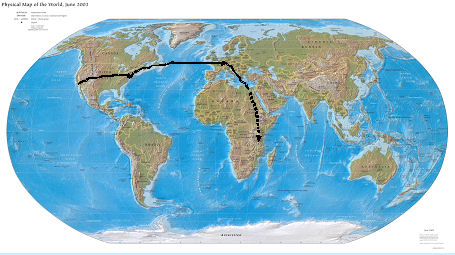
Flying from Amsterdam was interesting. When we took off it was snowing and clouds covered all of Europe. The clouds broke just as we were passing over Venice and be the time the plane reached the African coast over Egypt we could see the ground clearly. It was late afternoon and the lowering sun cast shadows over the Sahara Desert. From 37,000 feet it was breathtaking- the desert stretches for thousands of miles and, unlike our Mojave, it is virtually all sand. We could see ancient watercourses, oases and small areas of agriculture, finally seeing the glint of the Nile as the sun set into the west.
Arriving at Kilimanjaro Airport at about 10 pm we disembarked and met others of our Overseas Adventure Travel (OAT) group and a driver who was to take us to Olasiti Lodge in Arusha, about 1 ½ hours drive.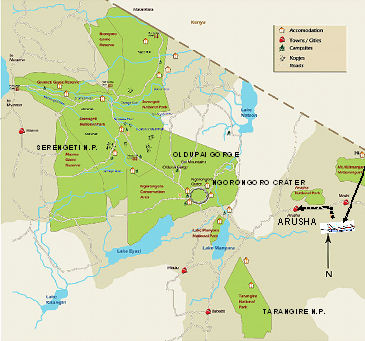
Once there we were assigned a room and quickly fell asleep, it had been a very long day.


(Click to see larger version of map)
After sleeping in beds surrounded by mosquito netting we awoke to a beautiful day. Outside the window were banana trees and the sounds of birds. Breakfast was at 8 am and we met the other 14 people that made up our travel group.

After breakfast the trip leader, Lube, gave us an orientation talk and then we climbed into a bus for a trip to the Shanga River House- a cooperative venture that teaches skills to disabled Tanzanians. As we waited to embark we were treated to singing emanating from the next door church. We drove through the streets of Arusha on market day (Sunday) as we made our way to the outskirts of the city.


Arusha is the largest city of northern Tanzania and many UN agencies, national organizations and NGOs have headquarters there. There is a monument in the center of the city that marks the central point, geographically, between Cairo, Egypt and Cape Town, South Africa- and we were four degrees south of the equator. The city may be large but it is not wealthy. Although we were told that there are some areas of large houses in the suburbs the downtown was bustling but it did have a third-world appearance and feel.

 The Shanga center is about three years old and was started by the wife of the adjacent coffee plantation’s manager.
The Shanga center is about three years old and was started by the wife of the adjacent coffee plantation’s manager.
We toured the coffee plantation led by Emmanuel; it’s about 2000 acres with more than one million coffee trees. It was a holiday so the coffee processing plant was quiet.


We enjoyed a guided tour of the Shanga center and watched the handicapped employees at work at various craft tasks.


We were treated to a lunch consisting of all local produce cooked in traditional ways. (Linda took the cook up on his offer to have someone from the group stir the polenta)



and then back to the lodge- where we promptly fell asleep until dinnertime. Ther next morning we were woken up early for breakfast and packed, ready to begin our first drive of the trip. We met the three driver-guides:
Lube (who also was the trip leader), 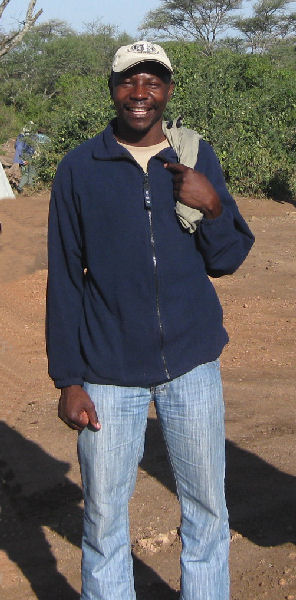 Dominick
Dominick 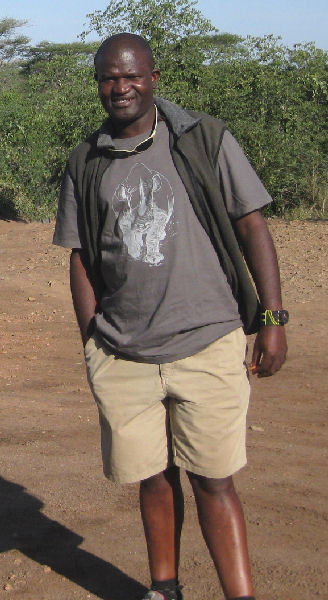 and Zeblon.
and Zeblon.
Each was driving a Toyota Land Cruiser with removable tops.  We could stand on the seats and have an unobstructed view, and all seats were by a window.
We could stand on the seats and have an unobstructed view, and all seats were by a window.


We drove through Arusha, stopped at a Cultural Heritage center and then drove west toward Lake Burunge and Tarangire National Park.




Driving on the paved main road we passed more coffee trees which changed to farmland and sporadic houses, then changing into the round huts and ‘bomas’ of the Maasai. Cows, sheep and an occasional camel could be seen in the fields. The cows have a particular significance: the Maasai believe that all cows belong to them and they measure wealth by the number of cows a man owns.

 We arrived at Tarangire National Park and ate lunch at a picnic area surrounded by extraordinarily colorful birds.
We arrived at Tarangire National Park and ate lunch at a picnic area surrounded by extraordinarily colorful birds.  From where we were sitting we could look through the brush and see gazelles browsing and an occasional monkey. Then we began our ‘safari’ in earnest and drove onto the dirt roads of the park.
From where we were sitting we could look through the brush and see gazelles browsing and an occasional monkey. Then we began our ‘safari’ in earnest and drove onto the dirt roads of the park.
Tarangire National Park enjoys a reputation for two main things: elephants and the Baobob Tree. 
 We bumped our way on the park’s unimproved roads for several hours. The drivers were amazing; they had the ability to spot the
We bumped our way on the park’s unimproved roads for several hours. The drivers were amazing; they had the ability to spot the 
movement or colors of animals while simultaneously talking to us and driving. We stopped often to view impala, gazelle, warthogs, monkeys, Kirk’s Dick-dick, giraffes and, of course, elephants.






Then out of the park to the Lake Burunge Lodge, a permanent tented camp located near the national park. We stopped at a local Maasai market- fruits, vegetables and artifacts for sale everywhere and, of course, we were approached immediately by vendors who followed us around.
The trip to the lodge called for several miles of dirt road along side an unfinished highway- dust everywhere! It was like riding over a washboard.
(Click here to experience the quality of the road.)
 We arrived at the camp and were assigned a tent. It was a several minute walk from the main lodge area and we found it to be on a platform with two beds surrounded by mosquito netting, a shower and a flush toilet.
We arrived at the camp and were assigned a tent. It was a several minute walk from the main lodge area and we found it to be on a platform with two beds surrounded by mosquito netting, a shower and a flush toilet.  The tent faced the lake and just outside was a termite mound half the height of the tent.
The tent faced the lake and just outside was a termite mound half the height of the tent.
We were instructed that we should not leave the  tent after dark unless escorted by a Maasai warrior- and his spear. We ate dinner in the main lodge and then a warrior escorted us back to the tent. We watched the stars for a while before retiring- at 9 pm.
tent after dark unless escorted by a Maasai warrior- and his spear. We ate dinner in the main lodge and then a warrior escorted us back to the tent. We watched the stars for a while before retiring- at 9 pm.
Up at 5:30 am for breakfast and the ride back to the national park for a full day of animal watching. A stop at the “Happy Room” before heading into the park and the rough, dusty roads.

We hadn’t gone more than ¼ mile when we stopped because gazelle, impala, elephants and giraffe were in the bush around us. 

We continued on, stopping frequently,
 as we came across more and more animals and exquisite birds with spectacularly bright and iridescent colors.
as we came across more and more animals and exquisite birds with spectacularly bright and iridescent colors.
Baboons, monkeys, warthogs and many, many elephants- solo bulls and large matriarchs with families with young.
 We marveled at the size of the Baobob trees and how the elephants sharpen and clean their tusks on the trunk creating large holes in the tree, occasionally even putting a hole completely through the trunk. Trees
We marveled at the size of the Baobob trees and how the elephants sharpen and clean their tusks on the trunk creating large holes in the tree, occasionally even putting a hole completely through the trunk. Trees 
 from horizon to horizon, mostly Acacia, in a variety of shapes and sizes all, however, with sizable thorns- even the Sausage tree had thorns.
from horizon to horizon, mostly Acacia, in a variety of shapes and sizes all, however, with sizable thorns- even the Sausage tree had thorns.
We watched giraffes eating the leaves of the Acacia, their lips curling around the thorns. At one point along the Tarangire River (translation: meandering river) we were nearly surrounded by elephants with one very little one (estimated to be one month old) scampering around and through the legs and making mock charges at the adults.


Waterbucks, hyenas and jackals moved across the savannah. The land appears endless and the grass was fairly high because it had rained the previous week. Although we saw some animals our guides emphasized that there is a LOT more life in the grass that we cannot see, including lions and leopards. They emphasized that an animal could be in the tall grass four feet away and we would not know it until it moved.
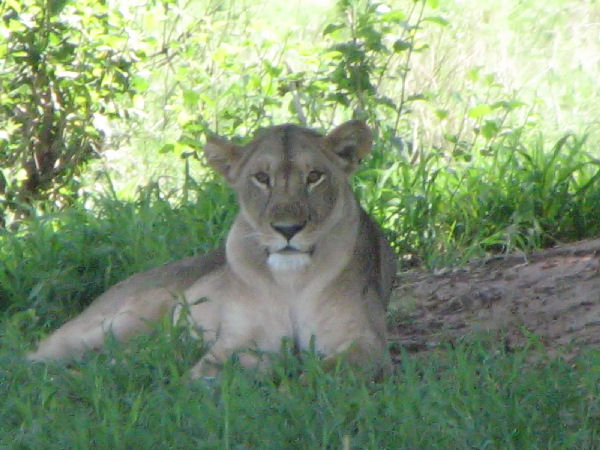
 At one point we saw a lioness and her cub resting in the shade of a Boabob tree. As we watched she spotted some warthogs and began to stalk them using the grass as cover. We watched as she moved across the road in front of us. Her cub watched as she moved out of sight and began to call “woo,” then moved to follow her scent crossing the road and disappearing into the tall grass- very exhilarating for our first lion sighting!
At one point we saw a lioness and her cub resting in the shade of a Boabob tree. As we watched she spotted some warthogs and began to stalk them using the grass as cover. We watched as she moved across the road in front of us. Her cub watched as she moved out of sight and began to call “woo,” then moved to follow her scent crossing the road and disappearing into the tall grass- very exhilarating for our first lion sighting!
Back at the lodge we met Lube and a Maasai, Jacob, for an hour-and-a-half walk. Jacob pointed out the native plants used as medicine and showed us the tracks of various animals that prowl the camp area at night.
 Climbing a small hill we had a fantastic view of Lake Burungi and the tops of the lodge’s tents. The lake, the roads and Tarangire National Park are all located, geographically, in the Rift Valley- the major fault that bisects the African continent.
Climbing a small hill we had a fantastic view of Lake Burungi and the tops of the lodge’s tents. The lake, the roads and Tarangire National Park are all located, geographically, in the Rift Valley- the major fault that bisects the African continent.



Up at 6:15 am for breakfast and then a drive to the Maasai village located near the national park. As we drove in the people  emerged from their huts in traditional garb (which we had been seeing them wearing as everyday clothes as we travelled) and beadwork neck rings.
emerged from their huts in traditional garb (which we had been seeing them wearing as everyday clothes as we travelled) and beadwork neck rings.

 The chief needed to perform a bloodletting ceremony on one of his cows- someone was ill in a neighboring ‘boma’ and the blood was used in the making of medicine. We all moved into the muddy and dung filled corral and watched as some of the warriors worked to isolate and catch the selected cow and then as the chief attempted to draw the necessary blood. He was not successful and announced he would attempt it later that afternoon.
The chief needed to perform a bloodletting ceremony on one of his cows- someone was ill in a neighboring ‘boma’ and the blood was used in the making of medicine. We all moved into the muddy and dung filled corral and watched as some of the warriors worked to isolate and catch the selected cow and then as the chief attempted to draw the necessary blood. He was not successful and announced he would attempt it later that afternoon.
The women chanted a welcome song (click here to see a video of the singing) as they dressed all of us up in traditional clothes. We stood in a circle while the women were led away by the tribeswomen and returned carrying (or attempting to) firewood balanced on their heads.



The chief and senior warriors performed a jumping dance and the chief would bump shoulders as a sign of acceptance and he did it with those of us who joined in, both men and women.
The women led us over to a boma and encouraged Linda to climb a wooden ladder and participate in thatching the roof. A couple of the other women took a turn thatching.
 The Maasai women then led us to another hut and sort of pulled Linda over and had her participate in placing a combination of mud and cow dung onto the wall- they washed her hands very carefully after the demonstration was over. I had taken out a Wet Wipe for Linda to use and one of the women noticed it. When I showed it to her and she smelled it she made a face and moved away- strange smells.
The Maasai women then led us to another hut and sort of pulled Linda over and had her participate in placing a combination of mud and cow dung onto the wall- they washed her hands very carefully after the demonstration was over. I had taken out a Wet Wipe for Linda to use and one of the women noticed it. When I showed it to her and she smelled it she made a face and moved away- strange smells.

 We all moved into the boma of the ‘first wife’ of the chief (always the first hut to the right in the compound) where we enjoyed an explanation of life in the hut and then a question and answer time with the Maasai woman; Lube acted as translator. She asked questions of us also. Before we left the women brought out homemade artifacts as a trade fair.
We all moved into the boma of the ‘first wife’ of the chief (always the first hut to the right in the compound) where we enjoyed an explanation of life in the hut and then a question and answer time with the Maasai woman; Lube acted as translator. She asked questions of us also. Before we left the women brought out homemade artifacts as a trade fair.
After leaving the village we stopped at a woodworking stand where men from the Maconde tribe were working on ebony and mahogany wood. Maconde art is collected worldwide and all men in the tribe are judged on their skill level- it determines his eligibility as a husband.
We drove up the Rift Valley and then towards its western slope towards the Ngorongoro Crater.
We drove up several thousand feet to the town at the lip of the crater where we turned onto a red dirt road passing fields of corn and small houses. Making a turn into the gate of Taloma Lodge- wow! It was like entering the Ojai Valley Inn- green lawns, beautiful flowers, well kept buildings, a majestic central building and swimming pool with birds everywhere, flying and singing. Also acres of gardens where organic foods are grown.


That evening, as we began dinner we were standing in the buffet line at there across the table were Shed and June Behar- who live in the upper Ojai… small world. They were on the same OAT tour but two weeks ahead of us and had just left the Serengeti and were on their way back to Arusha and home.
After breakfast we loaded into the Land Cruisers and headed towards the Serengeti National Park.
We stopped at the edge of the Ngorongoro Crater where we learned that it is a gigantic (3,200 square miles) caldera, the remains of a collapsed volcano- not a crater although that is what it is commonly called. We viewed the crater from the top of its 2000 foot high walls looking out over the 10 mile wide expanse. It is full of animals who are largely trapped in the crater. We continued driving around the crater’s rim towards the Serengeti knowing that we would go down into the crater for a day of wildlife viewing on our way back to Arusha, after five days “in the bush.”
that it is a gigantic (3,200 square miles) caldera, the remains of a collapsed volcano- not a crater although that is what it is commonly called. We viewed the crater from the top of its 2000 foot high walls looking out over the 10 mile wide expanse. It is full of animals who are largely trapped in the crater. We continued driving around the crater’s rim towards the Serengeti knowing that we would go down into the crater for a day of wildlife viewing on our way back to Arusha, after five days “in the bush.”


Coming down from the 7,500 foot height of the crater’s walls, driving through the Ngorongoro Highlands, we passed Maasai villages and herds of cattle until we drove out onto the flat plains of the Ngorongoro Conservation Area where we stopped at Oldupai Gorge.
 It was here in 1959 Mary and Louis Leakey unearthed 1.75 million year old fossil fragments which led to a new understanding of human evolution. “Lucy” was a Homo habilis, a race of early humans that survived the other species to become the early ancestors of modern humans. We listened to a lecture, wandered the museum and drove into the gorge to the spot where the fossils were found and had a second impromptu lecture by a local guide.
It was here in 1959 Mary and Louis Leakey unearthed 1.75 million year old fossil fragments which led to a new understanding of human evolution. “Lucy” was a Homo habilis, a race of early humans that survived the other species to become the early ancestors of modern humans. We listened to a lecture, wandered the museum and drove into the gorge to the spot where the fossils were found and had a second impromptu lecture by a local guide. 

Then back on the road bumping our way to the Serengeti National Park traveling at least 60 kilometers/hour- our driver-guide told us that driving more slowly would allow the vehicle to be caught by the ruts in the road and would be less controllable. Each time we passed another vehicle we had to quickly roll up the windows because of the dust.
(If you would like a sense of what the roads are like... click here)
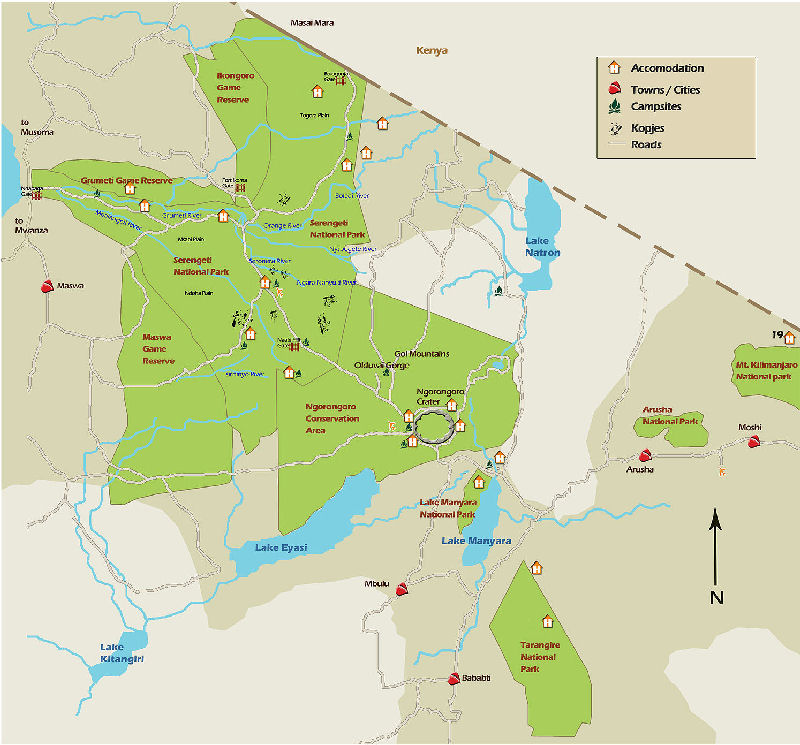
The Maasai people had been grazing their livestock on the wide, open plains of the Serenget (a Maasai word meaning “endless plain”) for over 2000 years before the British decided to make it into a game preserve (for hunting) in the early 1900’s. This was the precursor to the Serengeti National Park which was established in 1951. With he creation of the National Park, to preserve wildlife, the Maasai were relocated north to the Ngorongoro Highlands. It is the oldest of Tanzania’s national parks and the largest, covering 5,700 square miles of grasslands, savannas, ravines, forests and woodlands. It is most well known for the annual migration of 1.2 million wildebeest and nearly 600,000 zebra that pass through it.
We entered the park driving for a couple of hours north to where the camp was located, near the middle of the park at the base of a wooded hill. We were immediately struck by the apparent infinite expanse of the land and began to see animals throughout the landscape and alongside the road.

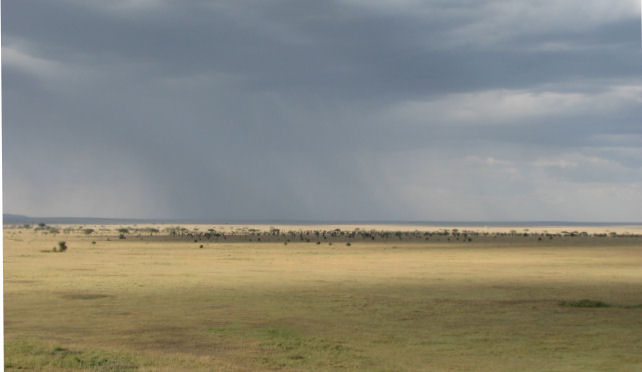
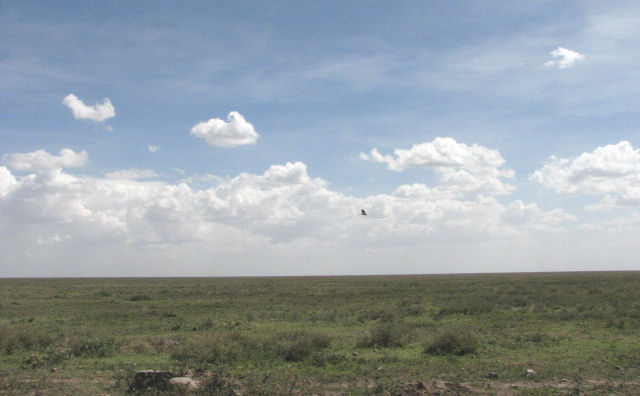




Reaching the camp we moved into our assigned tent. The was a tent for each couple, a dining tent and, slightly set apart, tents for cooking, food preparation and the staff and driver guides. Each of our tents had two beds, solar powered electric lights and a flush toilet and shower. The water was provided by a bucket system that allowed gravity-fed water to the shower and toilet. The staff would heat water for us and fill the bucket each day when we returned from our game viewing trips. They also provided hot water in canvas buckets for washing up each morning.



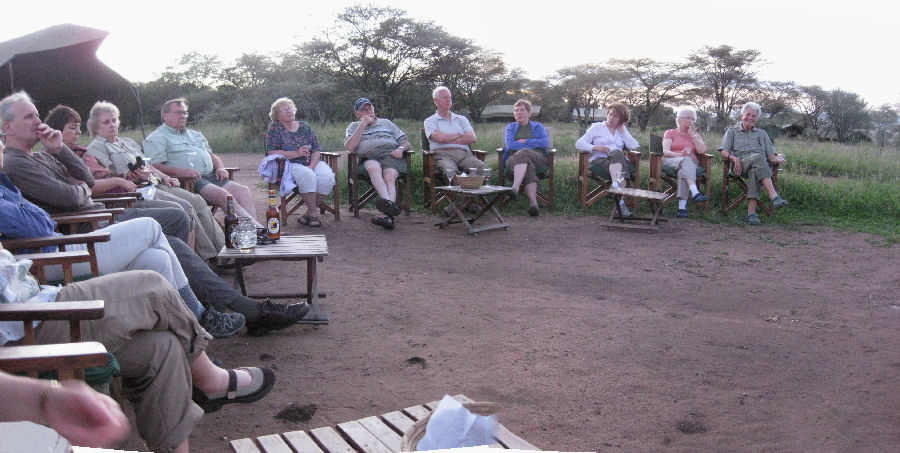
We met before dinner around a fire, watched the sun set and listened to Zabron tell us about the Serengeti. Then dinner and to bed. 
Each couple was escorted to the tent by one of the guides with a bright flashlight. We found a lantern had been hung in front of each tent and we were given a whistle and told not to leave the tent alone during the night. If we needed to leave the tent we were to summon someone using the whistle.
A 7 am wakeup, 7:30 breakfast and 8 am departure into the Serengeti. The morning game drive gave us a new appreciation of our guides’ abilities. Each could drive the rough roads, answer our questions and provide information about all of the flora and fauna, and  spot glimpses of ‘whatever’ that told him that there was something to see in the grass or in a tree. We
spot glimpses of ‘whatever’ that told him that there was something to see in the grass or in a tree. We 
were interested in the birds as well as the animals so the ‘jeeps’ were  stopping all the time while the guides kept in touch by radio. All sorts of animals: Thompson’s Gazelles, Grant’s Gazelles, elephants, wildebeest, zebras, ostrich, jackals, hyenas, warthogs, giraffes, lions and leopards.
stopping all the time while the guides kept in touch by radio. All sorts of animals: Thompson’s Gazelles, Grant’s Gazelles, elephants, wildebeest, zebras, ostrich, jackals, hyenas, warthogs, giraffes, lions and leopards.











One leopard was strolling down the road right next to the ‘jeeps’ and the call went out so that there were 23 vehicles clustered at
the spot
.

Back to camp for lunch, then a quick snooze and into the vehicles for an afternoon drive. Each time we left for a wildlife drive we would shift into a different vehicle so everyone met and learned from each of the three guides. We headed off in a slightly different direction and saw thousands of zebras as well as many other birds and animals, including lions.



[Click here for a video of a lioness hunting]
Back to camp for a shower and then to the evening campfire where Dominick talked about the ecosystem of the Serengeti and the migration. Then dinner and bed… we were almost always asleep by 9:30 pm.

A 6 am wakeup, 6:30 breakfast and at 7 we were in the trucks ready for the day’s adventure. This time it was a long, several hour ride towards the southwestern area of the park where the migration was passing through.
We drove by several giraffe along side of the road eating the Acacia trees, wildebeest grazing, hyena moving through 

grass and some cape buffalo lazing in the shade of the A trees.
Suddenly Dominick stopped the Land Cruiser and pointed to a sausage tree- a lioness was lying on a lower branch.
As we watched a family of elephants moved towards the tree from the left, and then a second family of elephants moved towards the tree from the right; 
 each family group contained babies.
each family group contained babies.

The lioness took notice because the elephants would not allow her to remain in place with babies around, and she cautiously climbed down from the tree and disappeared into the tall brush.

She emerged coming towards us and then, suddenly, a second lioness emerged and then a cub and then another…

all in all five cubs came out of the brush with the lionesses encouraging them away from the approaching elephants. What a terrific sighting!
We continued driving passing rocky outcrops in the plain called “kopjes” often with one or more lions lying on the top of the rocks.

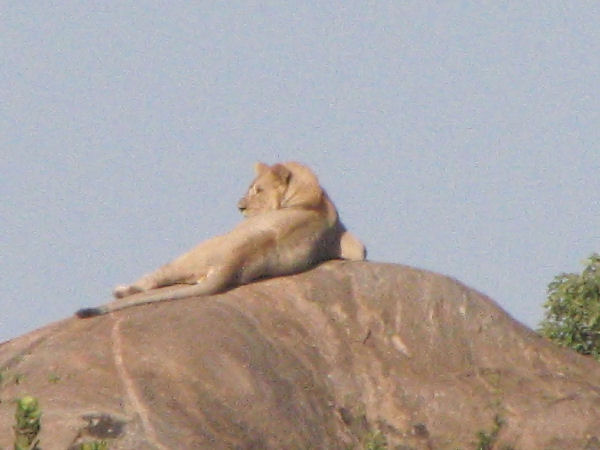



We passed through a “transition zone” of Acacia covered hills where rhinos were known to live- we did not see them; it’s also the area where tsetse flies live so we were thankful for the bug repellent we wore daily along with lots of sunscreen. 
After a “Happy Room” stop at a ranger camp we drove towards the open plain.
Suddenly Dominick stopped the car and told us to look down at the road; there were two dung beetles fighting over a piece of Wildebeest dung with a female beetle clinging to it! How he saw that while driving quickly over the dirt road exemplifies the high degree of training and skill each of our driver-guides exhibited. [Click here to see the Dung Beetle fight.]
We drove out onto a grassy plain and we began to see wildebeest and zebras. Generally they were not moving because the grasses were growing due to the rains and they were grazing. But they were everywhere we looked, 

from right next to the road to across the fields and plains- even the horizon was dotted with their forms. As we drove we passed a carcass being devoured by vultures and storks.
As we were scouting for a place to eat lunch Zeblon spotted a leopard in a tree. It had recently killed a young wildebeest and had carried it into the tree to protect from having it stolen by lions.



We found an Umbrella Acacia under which we ate a buffet lunch the guides had brought for us, surrounded by about 120,000 animals!




We drove through the herds- this is the only area in the park where the guides can go off the defined roads without a special permit- and then headed back towards camp passing gazelles, Topi, Dick-diks, elephants, impala, giraffe and dung beetles…
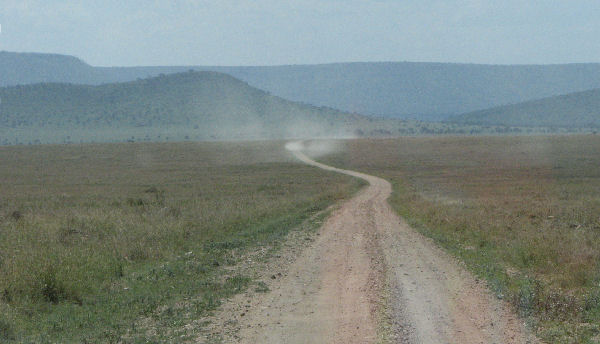 During the drive back to camp we suffered the only casualty of the trip- a flat tire, fixed very quickly. It was the only time we were allowed to exit the Land Cruiser while driving through the Serengeti.
During the drive back to camp we suffered the only casualty of the trip- a flat tire, fixed very quickly. It was the only time we were allowed to exit the Land Cruiser while driving through the Serengeti.




At camp we relaxed, did laundry and enjoyed a delicious dinner after listening to Lube talk about the marriage customs of his Bantu tribe, the Sukuma.
A 5:00 o’clock wake up and on the road by 6 am on a drive north in the Serengeti towards an area where we would find hippos.

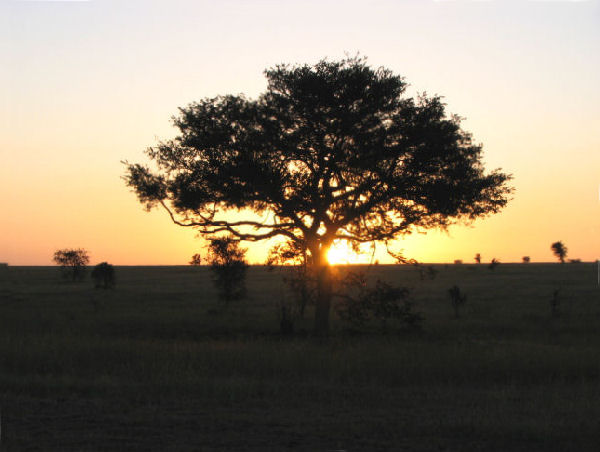

As we drove we saw hot air balloons over the Serengeti.
Entering the area where the hippos live we saw one meandering through the woods on the way to the water. There were lots of hippos in the pool and Nile Crocodiles sunning themselves on the rocks.





Back to the camp for lunch and after the meal we were offered a tour of the kitchen facilities then back into the trucks for a drive out to the kopjes.
We were treated to the sight of numerous lions relaxing on the rocks and we stopped to see Maasai paintings and a “gong rock.” When struck the hollow rock resounded over the plains calling people to a meeting.





On the way back we spotted a family of hyena on their den and more giraffe, impala, gazelle, jackals etc. That evening as we sat by the  campfire listening to Lube discuss our next day’s plan a cape buffalo calmly wandered by.
campfire listening to Lube discuss our next day’s plan a cape buffalo calmly wandered by.

We enjoyed a ‘farewell dinner’ and thanked the camp staff for their service. That night at about 1:15 am Jon and others were awakened by the sounds of a herd of cape buffalo moving around behind the tents- grunts, snorts, coughs and brush moving. The next morning Lube said that he fully expected to hear the sound of whistles and was pleasantly surprised when none were sounded especially, he went on, because a pair of lions had attacked a hyena that had been hanging around near the cooking tent.
The next morning the staff packed our bags into the Land Cruisers at a 7 am we were on our way back towards ‘civilization.’ As we drove out of camp we were treated to the sight of two cheetah sitting regally on a grassy termite mound. Exquisite!




We retraced our steps back to the Ngorongoro Crater where we drove a steep and curving road the 2000 feet down to the crater’s floor.
Inside the crater we encountered a concentration of the same animals we had been seeing plus flamingos and the black rhinoceros.
We watched hyena attempting to cut out baby wildebeest (unsuccessfully), zebra rolling in dirt patches, jackals hiding from the direct sun under rocks, lions relaxing in the shade of small bushes and trees, and at least 2 black rhinos, a mother and baby, pretty close to the road- we did sight rhinos again later in the day but much further away.




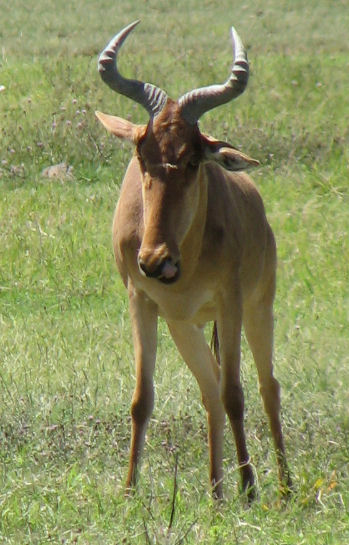





We ate lunch by one of the permanent lakes in the crater. A beautiful setting where we had to keep ducking from birds that attempted to take our food out our hands while we were eating.
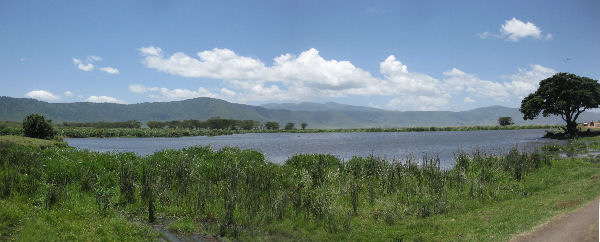

We noticed a serenity within the crater. Animals who, in the Serengeti, would run away at our approach, calmly watched us or just continued to go about their business.



As we prepared to climb out of the crater passing through a dense forest area we came across a troop of baboons about to cross the road. There were easily more than 100 of them- mothers with babies, adolescents, large males. They were playing and mock fighting with each other as they moved out of the woods and across the road between our vehicles. Several of them noticed our ‘jeep’ and climbed up onto the hood looking in at us watching them.

(Click here to see and hear the troop moving by our group.)
We drove up the narrow road to the crater’s rim and then back to Taloma Lodge, the place where we had stayed prior to heading into the Serengeti five days earlier.
The next day we had the opportunity to visit one of the schools near the lodge that the OAT Corporation supports through its Grand Circle Foundation- the Bashay Primary School in Karatu Village. Many of the people of our group were educators so this visit had a particular significance. We met with the principal and were impressed with how much he had accomplished with very few resources. His school was most fortunate to be associated with the GCF but it became so because it was judged to be among the most needy of the area.


The Foundation has helped build classrooms, purchase desks, rebuild the kitchen area and is planning to build a cafeteria. The school grows its own food in on-site gardens, yet does not have enough funds to feed all of the children, some of whom walk 5 or more miles to attend classes. All tour members were asked, prior to leaving for the trip, to bring some school supplies that could be donated to the school and the principal was most appreciative accepting the gifts.
We visited a 7th grade classroom and listened to the class sing the Tanzanian national anthem and then we sang them the participatory song “If you’re happy and you know it…” and several of them joined in the actions.
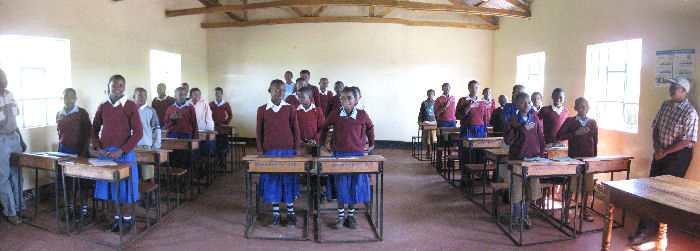
(Click on the picture to hear them singing.)
Lunch at Taloma Lodge and then we drove a short distance to visit with a Iraqw family. They demonstrated traditional crafts, examples of daily chores, and their traditional dress even asking several of our party to dress and participate in the dancing.





Several couples, we included, dressed in traditional wedding garments. We enjoyed an opportunity to move inside one of the houses, learn about the daily routines and have a chance to ask questions of the father of the family who acted as our local informant throughout our visit.
Later in the afternoon we joined a small group for a two-hour walk around the Taloma Lodge gardens and the surrounding area. We met some local children, visited a clay pit where sun-baked bricks were made and passed by the local health clinic.

Our last dinner in Tanzania was at the Taloma Lodge where we enjoyed our final meal of the trip. At breakfast we watched and listened to the ever-present Weaver birds… we saw them everywhere during this safari.
(Click here to watch and hear the Weaver birds.)
We climbed into the Land Cruisers for the last time for the ride back to Arusha. On the way we stopped, at the request of several of our party, at a “T” shirt store and then on to Olasiti Lodge where we had lunch- complete with a surprise birthday celebration for Lube.
(If you would like to see and hear the singing
of the lodge staff- click here.)
Just before lunch Jon became ill and remained so until we got home and for a week afterward – it made for a long trip home for him. We had time to rest and repack our bags before heading to the Kilimanjaro airport. As we were driving east towards the airport the clouds lifted and we were treated to a sight of Mount Kilimanjaro; what a nice ending to a most unusual and exhilarating trip.
20 hours and 8 time zones later we were back in California glad to be home but equally glad to have had the opportunity to experience the animals and people of the African continent. It was an extraordinary experience and we returned with wonderful memories and 1200 pictures, some of which we hope you have enjoyed here.